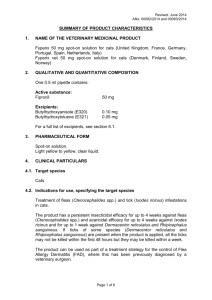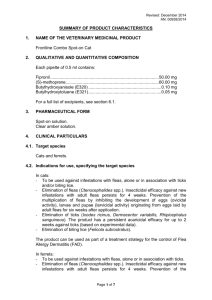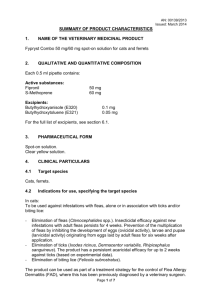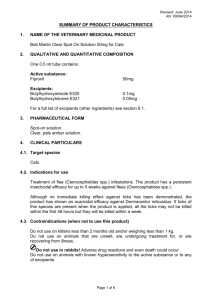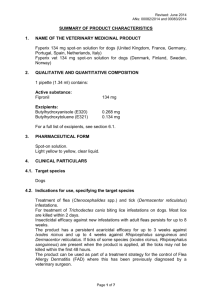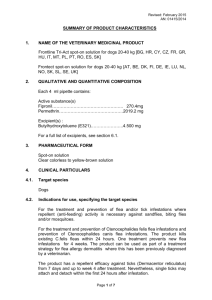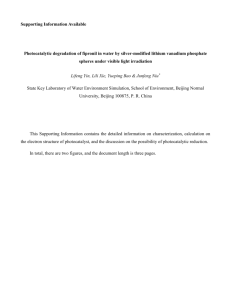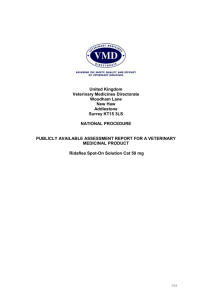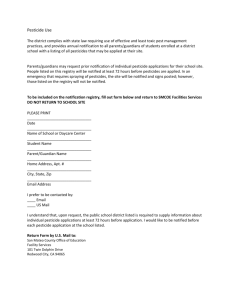quantitation pipetting
advertisement
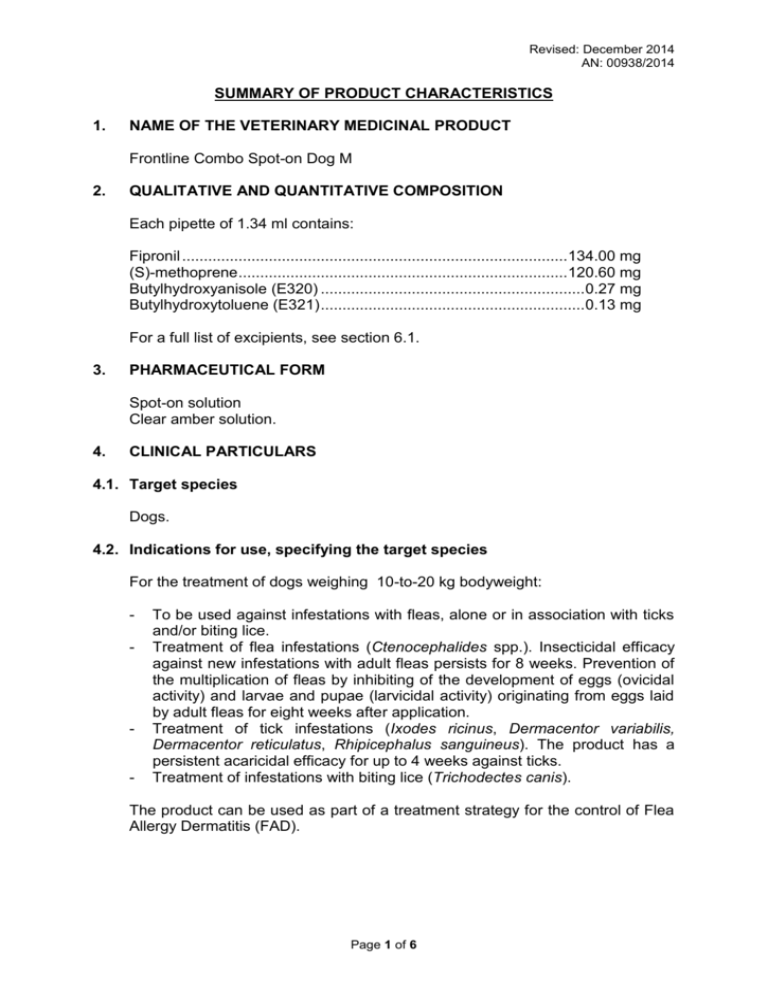
Revised: December 2014 AN: 00938/2014 SUMMARY OF PRODUCT CHARACTERISTICS 1. NAME OF THE VETERINARY MEDICINAL PRODUCT Frontline Combo Spot-on Dog M 2. QUALITATIVE AND QUANTITATIVE COMPOSITION Each pipette of 1.34 ml contains: Fipronil ......................................................................................... 134.00 mg (S)-methoprene ............................................................................ 120.60 mg Butylhydroxyanisole (E320) ............................................................. 0.27 mg Butylhydroxytoluene (E321) ............................................................. 0.13 mg For a full list of excipients, see section 6.1. 3. PHARMACEUTICAL FORM Spot-on solution Clear amber solution. 4. CLINICAL PARTICULARS 4.1. Target species Dogs. 4.2. Indications for use, specifying the target species For the treatment of dogs weighing 10-to-20 kg bodyweight: - - - To be used against infestations with fleas, alone or in association with ticks and/or biting lice. Treatment of flea infestations (Ctenocephalides spp.). Insecticidal efficacy against new infestations with adult fleas persists for 8 weeks. Prevention of the multiplication of fleas by inhibiting of the development of eggs (ovicidal activity) and larvae and pupae (larvicidal activity) originating from eggs laid by adult fleas for eight weeks after application. Treatment of tick infestations (Ixodes ricinus, Dermacentor variabilis, Dermacentor reticulatus, Rhipicephalus sanguineus). The product has a persistent acaricidal efficacy for up to 4 weeks against ticks. Treatment of infestations with biting lice (Trichodectes canis). The product can be used as part of a treatment strategy for the control of Flea Allergy Dermatitis (FAD). Page 1 of 6 Revised: December 2014 AN: 00938/2014 4.3. Contraindications In the absence of available data, the product should not be used on puppies less than 8 weeks old. Do not use on sick (e.g. systemic diseases, fever) or convalescent animals. Do not use in rabbits, as adverse reactions with even mortality could occur. In absence of studies, the use of the product is not recommended in non-target species. This product is specifically developed for dogs. Do not use in cats and ferrets, as this could lead to overdosing. 4.4. Special warnings for target species Bathing/immersion in water within 2 days after application of the product and more frequent bathing than once a week should be avoided, as no study has been performed to investigate how this affects the efficacy of the product. Emollient shampoos can be used prior to treatment, but reduce the duration of protection against fleas to approximately 5 weeks when used weekly after application of the product. Weekly bathing with a 2% chlorhexidine medicated shampoo did not affect efficacy against fleas during a 6 week long study. Dogs should not be allowed to swim in watercourses for 2 days after application (see section 6.6). There may be an attachment of a few ticks. For this reason a transmission of infectious diseases cannot be completely excluded if conditions are unfavourable. Fleas from pets often infest the animal's basket, bedding and regular resting areas such as carpets and soft furnishings which should be treated, in case of massive infestation and at the beginning of the control measures, with a suitable insecticide and vacuumed regularly. 4.5. Special precautions for use i) Special precautions for use in animals Avoid contact with the animal’s eyes. It is important to make sure that the product is applied to an area where the animal cannot lick it off and to make sure that animals do not lick each other following treatment. ii) Special precautions to be taken by the person administering the veterinary medicinal product to animals This product can cause mucous membrane, skin and eye irritation. Therefore, contact of the product with mouth, skin and eyes should be avoided. Animals or operators with a known hypersensitivity to insecticides or alcohol should avoid contact with Frontline Combo Spot-on Dog. Avoid contents coming into contact with the fingers. If this occurs, wash hands with soap and water. Page 2 of 6 Revised: December 2014 AN: 00938/2014 After accidental occular exposure the eye should be rinsed carefully in pure water. Wash hands after use. Treated animals should not be handled until the application site is dry, and children should not be allowed to play with treated animals until the application site is dry. It is therefore recommended that animals are not treated during the day, but should be treated during the early evening, and that recently treated animals are not allowed to sleep with owners, especially children. Do not smoke, drink or eat during application. 4.6. Adverse reactions (frequency and seriousness) Among the very rare suspected adverse reactions, transient skin reactions on the application site (skin discoloration, local hair loss, itching,redness) and general itching or hair loss have been reported after use. Excessive salivation, reversible nervous signs (increased sensitivity to stimulation, depression, other nervous signs), vomiting or respiratory symptoms have also been observed after use. If licking occurs, a brief period of excessive salivation may be observed due mainly to the nature of the carrier. Do not overdose. 4.7. Use during pregnancy, lactation or lay The product can be used during pregnancy and lactation. 4.8. Interaction with other medicinal products and other forms of interaction None known. 4.9. Amounts to be administered and administration route One pipette of 1.34 ml (M) per dog weighing over 10 kg and up to 20 kg, corresponding to a minimum recommended dose of 6.7 mg/kg for fipronil and 6 mg/kg for (S)-methoprene, by topical application to the skin. In the absence of safety studies the minimum treatment interval is 4 weeks. Page 3 of 6 Revised: December 2014 AN: 00938/2014 Method of administration: Hold the pipette upright. Tap the narrow part of the pipette to ensure the contents remain within the main body of the pipette. Snap back the tip. Part the coat on the back of the animal at the base of the neck in front of the shoulder blades until the skin is visible. Place the tip of the pipette on the skin and squeeze the pipette several times to empty its contents completely and directly onto the skin in one spot. Temporary changes to the coat (clumped/greasy hair) may be noted at the application site. 4.10. Overdose (symptoms, emergency procedures, antidotes), if necessary No adverse effects were observed in target animal safety studies in 8 week-old puppies, growing dogs and dogs weighing about 2 kg treated once at five times the recommended dose. The risk of experiencing adverse effects (see section 4.6) may however increase when overdosing, so animals should always be treated with the correct pipette size according to bodyweight. 4.11. Withdrawal period Not applicable. 5. PHARMACOLOGICAL PROPERTIES The product is an insecticidal and acaricidal solution for topical use, containing an association of an adulticidal active ingredient, fipronil, in combination with an ovicidal and larvicidal active ingredient, (S)-methoprene. ATCVet code: QP53AX65, group Ectoparasiticides for topical use incl. insecticides QP53. 5.1. Pharmacodynamic properties Fipronil is an insecticide and acaricide belonging to the phenylpyrazole family. It acts by interacting with ligand-gated chloride channels, in particular those gated by the neurotransmitter gamma-aminobutyric acid (GABA), thereby blocking pre- and post-synaptic transfer of chloride ions across cell membranes. This results in uncontrolled activity of the central nervous system and death of insects or acarines. Fipronil kills fleas within 24 hours and ticks (Dermacentor reticulatus, Dermacentor variabilis, Rhipicephalus sanguineus, Ixodes scapularis, Ixodes ricinus, Haemaphysalis longicornis, Haemaphysalis flava, Haemaphysalis campanulata) and lice within 48 hours post-exposure. (S)-Methoprene is an insect growth regulator (IGR) of the class of compounds known as juvenile hormone analogues that inhibit the development of immature stages of insects. This compound mimics the action of juvenile hormone and causes impaired development and death of the developing stages of fleas. The on-animal ovicidal activity of (S)-methoprene results from either direct penetration of the eggshell of newly laid eggs or from absorption through the cuticle of the adult fleas. (S)-methoprene is also effective in preventing flea Page 4 of 6 Revised: December 2014 AN: 00938/2014 larvae and pupae from developing, which prevents contamination of the environment of the treated animals with the immature stages of fleas. 5.2. Pharmacokinetic particulars Studies of metabolism of fipronil have demonstrated that the major metabolite is the sulfone derivative of fipronil. (S)-methoprene is extensively degraded into carbon dioxide and acetate that are subsequently incorporated into endogenous materials. The pharmacokinetic profiles after topical application of fipronil and (S)methoprene in combination were studied in dogs in comparison to intravenous dosing of fipronil or (S)-methoprene alone. This established absorption and other pharmacokinetic parameters. The topical application resulted in low systemic absorption of fipronil (11%) with a mean maximum concentration (Cmax) of approximately 35 ng/ml fipronil and 55 ng/ml of fipronil sulfone in plasma. Peak fipronil plasma concentrations are slowly attained (mean tmax approximately 101 h), and decline slowly (mean terminal half-life approximately 154 h, highest values are observed for males). Fipronil is extensively metabolised to fipronil sulfone after topical administration. Plasma concentrations of (S)-methoprene were below the limit of quantitation (20 ng/ml) in dogs after topical application. Both (S)-methoprene and fipronil, together with its major metabolite, are welldistributed in the haircoat of a dog within one day after application. The concentrations of fipronil, fipronil sulfone and S-methoprene in the hair coat decrease with time and are detectable for at least 60 days after dosing. Parasites are killed through contact rather than systemic exposure. No pharmacological interaction between fipronil and (S)-methoprene was noted. 6. PHARMACEUTICAL PARTICULARS 6.1. List of excipients Butylhydroxyanisole (E320) Butylhydroxytoluene (E321) Ethanol Polysorbate 80 (E433) Polyvidone Diethylene glycol monoethyl ether 6.2. Incompatibilities None known. Page 5 of 6 Revised: December 2014 AN: 00938/2014 6.3. Shelf life Shelf life of the veterinary medicinal product as packaged for sale: 3 years. 6.4. Special precautions for storage Do not store above 30°C. Store in the original package. 6.5. Nature and composition of immediate packaging Nature of primary packaging A green pipette composed of a heat-formed shell (polypropylene and polyacrylonitrile-methylate copolymer) and a film (polyethylene terephthalate, aluminium, and polyacrylonitrile-methylate copolymer). Sales presentation(s) and administrative number(s) of identification Blister card of 1 x 1.34 ml pipette with a scored tip Box of 1 blister card of 3 x 1.34 ml pipettes with a scored tip Box of 1 blister card of 4 x 1.34 ml pipettes with a scored tip Box of 2 blister cards of 3 x 1.34 ml pipettes with a scored tip 6.6. Special precautions for the disposal of unused veterinary medicinal product or waste materials derived from the use of such products Any unused product or waste material should be disposed of in accordance with national requirements. Fipronil and (S) methoprene may adversely affect aquatic organisms. Do not contaminate ponds, waterways or ditches with the product or empty containers. 7. MARKETING AUTHORISATION HOLDER Merial Animal Health Limited PO Box 327 Sandringham House Harlow Business Park Harlow Essex CM19 5TG 8. MARKETING AUTHORISATION NUMBER Vm 08327/4212 9. DATE OF FIRST AUTHORISATION Date: 29 January 2004 10. DATE OF REVISION OF THE TEXT Date: December 2014 Approved: 19 December 2014 Page 6 of 6
